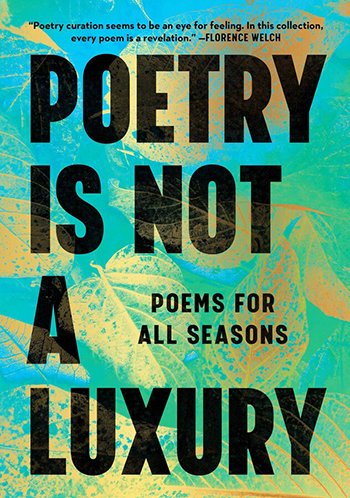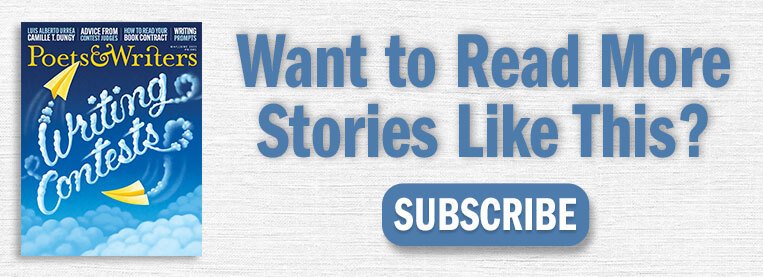The person behind the viral Instagram account @poetryisnotaluxury, which has garnered more than 845,000 followers, says they started the page in 2016 “almost by accident.” When their father got sick that winter, the curator, who prefers to remain anonymous, began collecting poems in screenshots, taking pictures of pages in books that particularly moved them, and posting the poems on Instagram. After losing their father, they described reading poetry in that time of grief as necessary for “emotional survival.” They named the page after the Audre Lord quote “Poetry is not a luxury” because it resonated with their belief that poetry “is our foundation and holds the promise and power to free us.” The anonymous curator has now edited a book, Poetry Is Not a Luxury: Poems for All Seasons, forthcoming from Washington Square Press, an imprint of Atria Books, on May 6.

The poems in Poetry Is Not a Luxury are sorted into four sections, starting with Summer, and moving through Fall, Winter, and Spring. Some of the poems (like “Summer Solstice” by Jenny Zhang, “Fall Song” by Joy Harjo, “To the Winter Apricot Blossom” by Emily Jungmin Yoon, and “Praise Spring” by Linda Gregg) are clearly rooted in their season. Others appear to have been sorted by a looser, more poetic, logic. The anonymous editor confesses that “with many of the poems the boundary between each section is porous…the way we might swing into the same mood as winter shifts to spring and once again feel that pang of change as summer ends.” Though seasons are often marked by precise dates and by their defining characteristics—foliage, frost, flowers—they, too, are porous. After all, sometimes it snows in April; increasingly, warm spells make for a muggy November. The sections that partition Poetry Is Not A Luxury are intentionally permeable. The subtitle of the anthology acknowledges this fluidity explicitly—it’s not “Poems for Each Season,” but rather “Poems for All Seasons.”
In our conversation below, which has been edited for clarity and length, the curator discusses their approach to selecting poetry for a digital platform versus a print anthology, trends in the poems that readers respond to, the value of anonymity, and the old grooves poems occupy in our lives.
As you curate @poetryisnotaluxury, do you look for poems that move you personally? Political poems that might move the masses? Are there times when you feel on the fence about sharing a poem?
The poems that move me are the poems I post. There are so many times when I am on the fence about what to post—when I love too many poems in a new book, choosing the perfect one to demonstrate what is so stunning about the poet’s voice is challenging.
Have you noticed any patterns in the poems people respond to? Does the scope and platform of Instagram affect the poems you choose to share?
The poems that we needed during the pandemic were different from the poems we need now. Over the ten years that I have been posting, I think love poems and poems of liberation get the most response from readers. People respond to any poem that calls into question the mainstays of our humanity. I think we seek poetry that inspires us to change and grow or that reminds us how similar we are to one another.
When I first started, I posted all the poems I read each morning and thought less about what the audience and the platform wanted. Now I do tend to share smaller poems that photograph well and fit into the format of the platform. There are plenty of longer poems that I love, but sharing them on Instagram seems prohibitive to everyone’s eyesight and attention span. The anthology is where I took my chance to pick poems that I could not share on a screen.
What inspired you to turn the Instagram account into a book? How did you begin thinking through how to structure a print anthology?
I feel like I was putting an anthology together as I posted poems to Instagram, always stringing them in a row, connected by similar themes or hues. As I read, my mind seems to naturally file poems into categories.
It was a vision that someday I would be able to take the poems from the screen and put a collection together. One day I got a letter from a literary agent who saw the possibility of turning the [account] into a collection or series of poetry anthologies. She connected me with an editor at Atria, and we started working on the book. We had a few different ideas for the structure, but “the seasons” was one of the themes that we all felt excited about.
How did you approach the sequencing of poems in the anthology differently from the Instagram page?
I think it is similar to the way I choose poems to post but with an ever more thoughtful eye to the flow from one poem to the next, knowing that the reader would be sitting with the book and likely be reading them in a row instead of running across the poems in their feed or in someone’s Instagram stories.
You write that this anthology is a “mixtape” you made for readers. And you also cite Stevie Wonder’s quote, “the seasons know exactly when to change.” Can you say a bit about the connection between poetry and music?
Many of my first favorite poets were also songwriters like Leonard Cohen, Gil Scott-Heron, Patti Smith, and David Berman. I used to memorize the lyrics to songs and those words helped me find myself and led me to my own words. I think poet Jim Harrison put it best—I am a “word drunk.” With music, the notes are made to move through you and evoke feelings. In poetry, the music is in the formatting and the structure. As you read a poem the beat comes in and you are, if it is a good poem, inside the song.
Did you choose the season based on an emotion the poem evoked in you? How fluid are the boundaries between these sections?
With many of the poems the boundary between each section is porous, yes, the way we might swing into the same mood as winter shifts to spring and once again feel that pang of change as summer ends. I have old grooves that many of these poems live in, so it was clear to me which season they belonged to. Though you could flip through the book and read at random.
So much of the digital world—and social media in particular—is about presentation and providing others “proof” of your experiences. For instance, there is the wry, somewhat self-aware internet adage, “Pics or it didn’t happen.” How did you decide to embark on this project anonymously? What does anonymity mean to you?
It was more of an aesthetic choice to create a page that felt like a magazine with poems to scroll through and read, more like a book or collection than an Instagram page. I wanted to focus solely on poetry, to shine all the light on the poets. As it grew, it became an opportunity to amplify the words of lesser-known poets. It grew into a place of poetry, offering readers a daily dose of good words. Remaining anonymous for me is the best way to do this work.
How much has curating poetry as a daily practice transformed you as a reader, writer, and person?
Reading poetry daily has changed me more than curating poetry. Having these words to return to as support and inspiration has helped me to cope with life.... Turning that very personal habit into a public page has been a gift. I have found a community.
Serena Alagappan is a senior editor at Poets & Writers Magazine.
thumbnail image credits: summer, Josie Weiss; fall, Sydney G; winter, Klara Kulikova; spring, filterlate.







